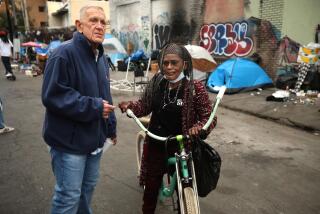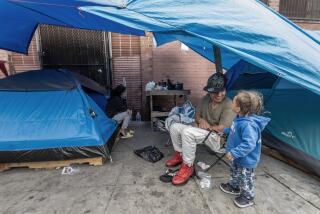Group Retains Its Mission as Face of Needy Changes : Homeless: Helpers for the Homeless and Hungry has provided groceries and shelter to the poor since 1972. Today, only the clientele has changed.
The face of need has changed over the years outside the small storefront office where volunteers for the Crenshaw-based Helpers for the Homeless and Hungry distribute free groceries to the poor twice a month.
When G. Landry founded the organization in 1972, she was addressing a specific problem: She was providing food and shelter for people, mostly elderly black women, who had become homeless and destitute because of severe illnesses, such as cancer.
In 1989, the clientele is more diverse. There are elderly people with shopping carts, young families with children, and, most numerous of all, victims of the city’s drug epidemic, all crowding around the small doorway waiting for plastic bags packed with bread, canned fruit and vegetables and other items.
“There are many walking wounded in our community,” says Landry, a New Orleans native who uses only her first initial as her given name. “Today’s homeless population has many different faces.”
In addition to providing food and clothing to about 100 needy individuals and families, Helpers for the Homeless and Hungry, located on Slauson Avenue just east of Crenshaw Boulevard, operates a job-training program and several small shelters, where up to 20 homeless people are housed until they find jobs and raise enough money for their first and last month’s rents.
“We wish we could do more but we can’t,” said Kaye Martin, director of the program, which operates on small federal grants and donations from local businesses and churches. “Because there is such a lack of resources in the Crenshaw area, most homeless people go where they know they can get help. . . . That’s often downtown or in Santa Monica.”
Unlike the larger downtown shelters and missions, which attract homeless people from all over the region and from other states as well, most of the people who walk through the doors of Helpers for the Homeless and Hungry are the down and out from nearby neighborhoods in South Los Angeles, Martin said.
Despite the need, she said, the plight of Crenshaw’s homeless population has gone largely unnoticed when compared to the widespread publicity given to the problem in such places as Santa Monica, West Hollywood and downtown’s Skid Row. “Sometimes it’s hard to convince people that we even have a problem, but our record speaks for itself,” Martin said.
Recently, however, the group has begun to receive a bit more recognition for its efforts.
As part of a holiday appeal, City Councilwoman Ruth Galanter, who represents a portion of the Crenshaw area, urged her constituents to volunteer or contribute money to help the homeless, and singled out Helpers for the Homeless and Hungry as an organization that was particularly worthy of support.
“They were out there helping people long before it became fashionable to help the homeless,” said Valerie Shaw, Galanter’s representative in the Crenshaw area.
City Councilman Robert Farrell, whose district also includes parts of the Crenshaw community, described the group as a “wonderful resource for poor people to turn to for help, because there simply isn’t enough money in the public sector to do the whole job.”
Other significant supporters include radio station KJLH and singer-songwriter Stevie Wonder, who recently chartered a bus for 35 homeless people and supporters of Helpers for the Homeless and Hungry to travel to Washington to lobby and attend a rally to draw attention to the needs of the homeless.
KJLH spokeswoman Pat Hewett said the station supports Helpers because its volunteers “do so many things.”
“When these women go out to feed the homeless . . . they bring food that they cook from their own kitchens, the kind of food anyone would want to wait in line for.”
Helpers for the Homeless and Hungry is an offspring of Women’s Network For Cancer Prevention, which Landry founded in 1972 to educate blacks and other minority women about the dangers of cancer.
“After losing my grandmother to cancer, I decided to see what I could do to help other poor women to protect themselves,” Landry said. “Shortly after forming that organization, I took into my home a friend who had become gravely ill and had no place to go. It was at this time that I became aware of the many women who were homeless because of illness.”
Today’s homeless problem, Landry said, is not as easily defined.
“We have a hidden homeless problem,” she said. “There are people who have jobs and are forced to live in their cars because they can’t afford to raise the money for the first and last month’s rent. There are people who sleep on the street at night and come to our office in the morning and ask if they could use the restroom to wash up because they are on their way to work.”
Elmyra, 50, walked into the group’s headquarters five months ago and asked to be sheltered after being forced out of her home by a nephew who stole most of her belongings to support a cocaine habit.
“I was stranded,” she said. “I came to Los Angeles after my divorce to live with my sister, but I had no idea what I was getting into.” Elmyra lives in a small apartment shelter with three other women. She hopes to move early in the new year, after she has saved enough money for an apartment from her job as a cashier for a check-cashing store.
Adrian, another resident, recently left her cocaine-addicted husband with the hopes of starting a new life for herself and her 6-year-old daughter.
“My daughter and I have each other--and now we are putting our lives back together,” she said.
More to Read
Sign up for Essential California
The most important California stories and recommendations in your inbox every morning.
You may occasionally receive promotional content from the Los Angeles Times.










